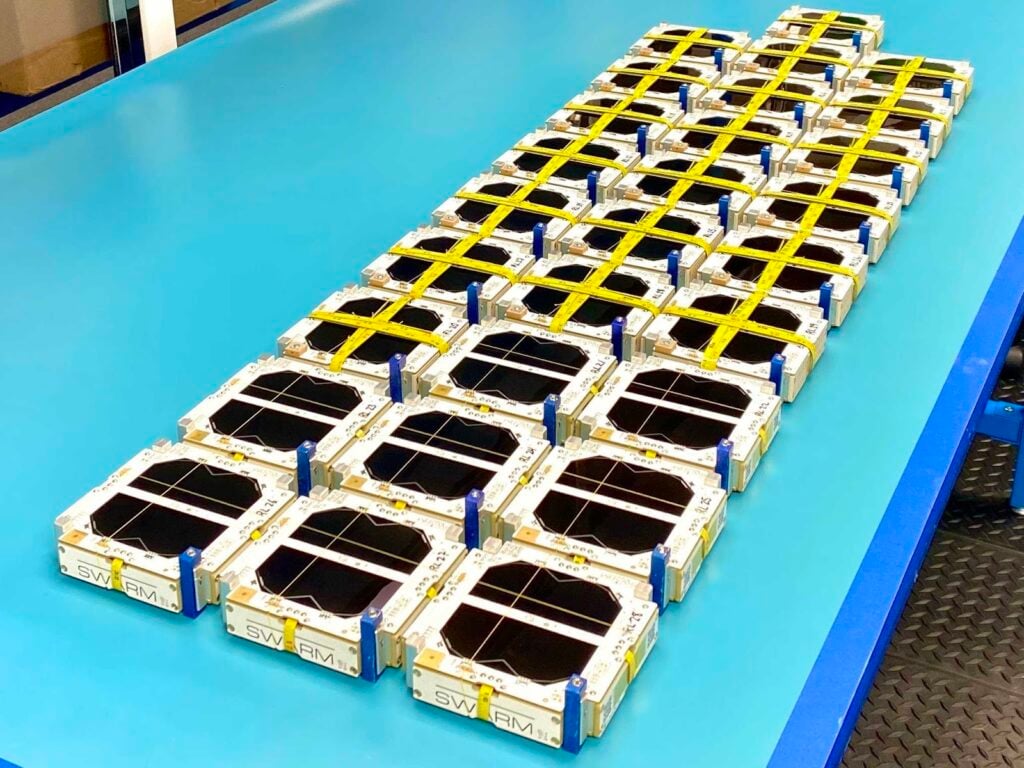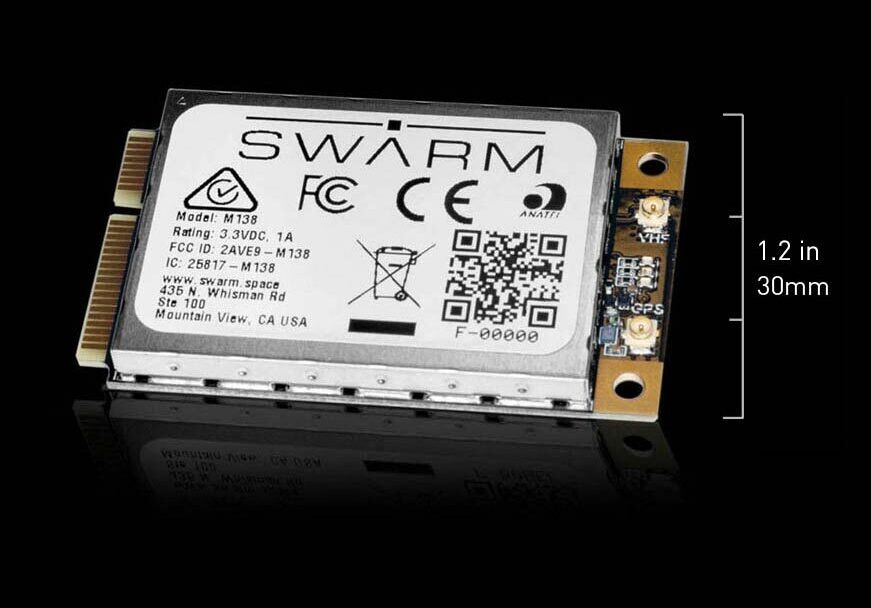
Swarm Chats: Jonny Dyer, Former Chief Engineer of Skybox
December 1, 2020
Welcome to our new Swarm Chats series. We will be interviewing experts across industries – from aerospace to agriculture – to hear their take on the future of the space and IoT industries, and where they see Swarm fitting in.
The space industry is advancing more rapidly – and becoming more crowded – than ever. Barriers to entry are lower, companies are moving faster, and projects thought to be infeasible a few years ago are getting massive influxes of venture capital.
Jonny Dyer knows more than a little about this brave new world. He is the former Chief Engineer of Skybox Imaging, the innovative startup that developed small, high-resolution imaging satellites. Skybox was the first company to enter the market with small sats, paving the way for companies like Swarm. Jonny has also held engineering roles at Google and Lyft. He is a technical advisor on the Environmental Defense Fund’s MethaneSat mission and advises several startups, including Swarm.
Swarm’s CEO and co-founder, Sara Spangelo, sat down for a virtual chat with Jonny to discuss the current state of the space industry, his advice for young startups, and to get his perspective on how Swarm is changing the game in low-cost global connectivity.
Sara Spangelo: You spent seven years at Skybox and you’re now an advisor to various aerospace companies and projects. What are you seeing in the industry right now that has you most excited?
Jonny Dyer: It’s great to see how much energy there is and the amount of capital coming in. It’s gotten super cool to be doing stuff in space, and you don’t need to go to Raytheon or Boeing to do it. For one thing, launch has dramatically improved. We struggled so much with launch at Skybox, it almost killed the company a couple of times. It’s still challenging, but there are so many more and better options now. That really changes the whole nature of the game.
It’s also satisfying to see the transition away from needing to prove these things are possible. We were regularly questioned about why we thought Skybox was even technically possible. There was a lot of doubt from investors. People aren’t asking those questions as much now; they’re more focused on asking the business questions and scaling questions and execution questions. I like the fact that there’s more of a software mindset – I’ll call it a “Silicon Valley mindset” – in space now: move fast and break things. It’s brought in a lot of fresh ideas.
I like the fact that there’s more of a “Silicon Valley mindset” in space now: move fast and break things. It’s brought in a lot of fresh ideas.
SS: What has you most frustrated about the space industry?
JD: I still see a lot of the “build it and they will come” mentality. A lot of people are doing something they think is cool without figuring out how it will become a business. We were somewhat guilty of that at Skybox, but we had a reasonable thesis about the existing market and why it would grow over time. Some companies are not even that far in their thinking.
Also, Silicon Valley mindset aside, Space is still hard and I see a ton of people who have forgotten that. There’s a lot of poor engineering fundamentals going on; a lack of rigor. While there is a lot to be said for doing things differently, the traditional aerospace world has 60+ years of accumulated expertise that can be learned from and it’s silly to make mistakes that could have been avoided. Many groups focus on something very narrow and miss the systems view. That’s true on both the technical and the business side. Then they end up with some small part working well but nothing else around it. That’s a bad place to be in. Things don’t have to be perfect on the first iteration, but it shouldn’t come at the expense of some upfront thought.
While there is a lot to be said for doing things differently, the traditional aerospace world has 60+ years of accumulated expertise that can be learned from and it’s silly to make mistakes that could have been avoided.
SS: The barriers to entry for the space industry are a lot lower now. Anyone can launch anything pretty cheaply and it’s easy to raise money, but space is still hard and it requires a lot of parts. It’s not like deploying an app. You need a ground system, uplink… you’ve got to have a bare minimum.
JD: Exactly, that’s what I mean by the systems view. It’s a puzzle and all these things have to fit together tightly to produce something valuable.
SS: What advice would you give to small aerospace startups like Swarm in their first few years?
JD: Product excellence and satisfying customers. Make sure customers are getting what they need, aside from just the technical things.
And be careful how you balance investment. One of the problems we ran into at Skybox is that it’s easy for the space part to suck all the focus away from business problems because it’s cool and it’s hard. We struggled to invest sufficiently on the product side until much later. I see a lot of people who have succumbed to this. They’ve spent a huge amount of time, money, and effort on a satellite and they’re just now realizing that getting to a product is going to require big investments in other areas.
Also, true agility is driven by keeping things simple and burning down risks early, rather than just hacking and slashing things together. Focus early thought and energy on how you meet the product needs as simply and elegantly as possible, rather than building some kind of super complex, over-engineered system that didn’t have much disciplined thought process behind it.
True agility is driven by keeping things simple and burning down risks early, rather than just hacking and slashing things together. Focus early thought and energy on how you meet the product needs as simply and elegantly as possible.
SS: One thing we did with Swarm early on was fly high-altitude balloons to simulate connectivity. That was a really interesting way to see if it was a real product that people wanted. And then we launched the simplest thing that we knew would work. It felt elementary at the time but I think it worked well.
JD: And it allowed you to test different dimensions of the bigger picture and see if they worked. It allowed you to test all the different pieces at a basic level and validate them.
SS: How do you think Swarm is differentiated relative to other space or satellite companies?

JD: You guys have been super scrappy and able to prove things out very quickly and with simple solutions, while still keeping a good bar of engineering quality. That combination of scrappiness but also diligence and rigor is pretty rare.
I also think the focus on early organic business growth and quickly getting to a product that customers want, versus needing hundreds of satellites and hundreds of millions of dollars in CapEx, is awesome. That’s something that very few – even among the “new space” group – have been able to do.
SS: Which are not unrelated to each other.
JD: Exactly, it’s a virtuous cycle.
I think the coolest part of Swarm’s tech is the elegance of how it fits together and how simple it is. You’ve been able to put together basic pieces in a clean and elegant way to solve a problem. There’s a quote from Antoine de Exupery in his memoir Wind, Sand and Stars, where he says something like “perfection is achieved not when there’s nothing left to add, but when there’s nothing left to take away.” That’s my definition of elegance – something that solves what it needs to solve in the simplest way. You guys are really close to that.
The coolest part of Swarm’s tech is the elegance of how it fits together and how simple it is. You’ve been able to put together basic pieces in a clean and elegant way to solve a problem.
SS: Over the past few years you’ve ventured into the mobility sector by joining Lyft. What do you think the impact of low-cost, global satellite connectivity will be on the mobility and transportation industry over the coming years?
JD: Mobility is transitioning from things we own to things we buy as a service – scooters, bikes, AVs. Those are inherently fleets of things, which require connectivity and coordination. They will require global, two-way connectivity. Systems like Swarm that allow reliable, persistent coverage anywhere in the world will enable that. The same goes for autonomous vehicles, especially when you’re in places with no other network connectivity. From a reliability standpoint, even if you have some ground infrastructure, all those systems will need redundant layers because safety is so critical. All that will be enabled by the global IoT data service, but it will probably take some time.
Mobility is transitioning from things we own to things we buy as a service. Those are inherently fleets of things that will require global, two-way connectivity. Systems like Swarm will enable that.
SS: Changing directions a bit to talk about your own career… what is one habit or way of doing things that you think has made you successful throughout your career?
JD: When you’re operating at the higher levels of an organization, finding ways to stay involved in the details is important. I pick little projects that force me to stay technical and dig in.
Recently, I’ve also learned the importance of being as honest and direct with people as possible. People are surprisingly resilient even in the face of things that are challenging for them to hear. Being direct is so impactful, versus trying to spin or sugar-coat things.
On the technical side, I’ve found it’s easy to get to a point where you think you need to compromise, due to schedule or whatever. And you sometimes have to, but I generally wait until the last possible minute. When you step back, there are often ways to do what you need to without compromising.
SS: I’m often surprised when you’re in crunch time and someone suddenly says “Why can’t we just do X, Y, Z?” It forces people to get really creative.
JD: Yes, and asking great questions to challenge someone’s thought process, even if you don’t have the answer yourself yet.
SS: What are you most excited about in your career journey right now?
JD: Mobility has taught me a lot of things that I wouldn’t have learned if I’d stayed in aerospace, especially machine learning and robotics. But I also miss the hard physics problems that space offers, and the adrenaline of “we’re going to launch this thing and it’s either going to work or not, there’s no inbetween.” If you’ve gone through that, it’s hard to do anything else. This is the first time in 15 years I’ve had a chance to take a step back and figure out what I want to be doing next.
SS: And my last question: if you could moonlight for a week in another career, what would you do?
JD: I think I would be a marine biologist. I would channel my inner George Constanza. Every time I go out to the coast and wander the tide pools, it’s really interesting. I’d probably grow a beard and get on a boat and just float around for a while.
—
This interview has been lightly edited for clarity and length.


